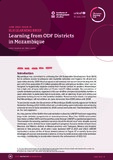Learning from ODF Districts in Mozambique
Aprendendo dos Distritos LIFECA em Moçambique
| dc.contributor.author | Uandela, André | |
| dc.contributor.author | Coultas, Mimi | |
| dc.coverage.spatial | Mozambique | en |
| dc.date.accessioned | 2023-06-12T15:55:02Z | |
| dc.date.available | 2023-06-12T15:55:02Z | |
| dc.date.issued | 2023-06 | |
| dc.identifier.citation | Uandela, A. and Coultas, M. (2023) ‘Learning from ODF districts in Mozambique’, SLH Learning Brief 14, The Sanitation Learning Hub, Brighton: Institute of Development Studies, DOI: 10.19088/SLH.2023.006 | en |
| dc.identifier.citation | Uandela, A. and Coultas, M. (2023) ‘Aprendendo dos Distritos LIFECA em Moçambique’, SLH Learning Brief 14, The Sanitation Learning Hub, Brighton: Institute of Development Studies, DOI: 10.19088/SLH.2023.010 | pt |
| dc.identifier.isbn | 978-1-80470-103-4 | |
| dc.identifier.uri | https://opendocs.ids.ac.uk/opendocs/handle/20.500.12413/18013 | |
| dc.description.abstract | Mozambique has committed to achieving the UN Sustainable Development Goal (SDG) 6.2 to achieve access to adequate and equitable sanitation and hygiene for all and end open defecation by 2030. Much progress is still needed, with recent data indicating that 36 per cent of the population (11.6 million people) still use unimproved facilities which are not designed to hygienically separate excreta from human contact. In addition, Mozambique has a high rate of open defecation at 23 per cent (7.1 million people). The prevalence of unsafe sanitation practices, regarded as the use of either unimproved sanitation facilities or open defecation, is particularly high in rural areas, with an alarming 75 per cent of the rural population lacking access to safe sanitation facilities. Based on these trends, it is projected that Mozambique will not achieve an open defecation free (ODF) status until 2068. To accelerate results, the Government of Mozambique (GoM) recently approved the Rural Sanitation Strategy (2021-2030) which aims at eliminating open defecation and achieving universal access to basic sanitation by 2030 using Community-led Total Sanitation (CLTS) as the core approach. As a key partner of the GoM in the rural sanitation subsector, UNICEF has been supporting large scale sanitation programmes in several provinces. | en |
| dc.description.abstract | Moçambique comprometeu-se a prosseguir o Objectivo de Desenvolvimento Sustentável da ONU (ODG) 6.2 com vista a alcançar o acesso ao saneamento e higiene adequados e equitativos para todos e acabar com o fecalismo a céu aberto até 2030. No entanto, ainda há muito a ser feito. Dados recentes indicam que 36 por cento da população (11,6 milhões de pessoas) ainda utilizam instalações não melhoradas que não foram concebidas para impedir higienicamente o contacto humano com excrementos. Além disso, Moçambique tem uma elevada taxa de fecalismo a céu aberto, situada em 23 por cento (7,1 milhões de pessoas). A prevalência de práticas sanitárias pouco seguras, como a utilização de instalações sanitárias não melhoradas ou fecalismo a céu aberto, é particularmente elevada nas zonas rurais, onde se verifica uma alarmante falta de acesso a instalações sanitárias seguras por parte de 75 por cento da população. Com base nestas tendências, prevê-se que Moçambique não alcançará um estatuto de país livre do fecalismo a céu aberto até 2068. Com vista a acelerar o alcance de melhores resultados, o Governo de Moçambique (GdM) aprovou recentemente a Estratégia de Saneamento Rural (2021-2030) que visa eliminar a defecação aberta e alcançar o acesso universal ao saneamento básico até 2030 utilizando o Saneamento Total Liderado pela Comunidade (CLTS) como abordagem central. Como parceiro-chave do GdM no subsector do saneamento rural, o UNICEF tem apoiado programas de saneamento em grande escala em várias províncias. | pt |
| dc.language.iso | en | en |
| dc.publisher | The Sanitation Learning Hub, Institute of Development Studies | en |
| dc.relation.ispartofseries | SLH Learning Brief;14 | |
| dc.rights.uri | http://creativecommons.org/licenses/by-nc/4.0/ | en |
| dc.subject | Health | en |
| dc.subject | Participation | en |
| dc.subject | Poverty | en |
| dc.subject | Water | en |
| dc.title | Learning from ODF Districts in Mozambique | en |
| dc.title | Aprendendo dos Distritos LIFECA em Moçambique | pt |
| dc.type | Series paper (IDS) | en |
| dc.rights.holder | Institute of Development Studies | en |
| dc.identifier.team | Participation | en |
| dc.identifier.doi | 10.19088/SLH.2023.006 | |
| dc.identifier.doi | 10.19088/SLH.2023.010 | |
| dcterms.dateAccepted | 2023-05-31 | |
| rioxxterms.funder | Default funder | en |
| rioxxterms.identifier.project | Sida | en |
| rioxxterms.version | VoR | en |
| rioxxterms.versionofrecord | 10.19088/SLH.2023.006 | en |
| rioxxterms.funder.project | 3f32bc13-1f3c-47d3-9de7-8df640669d8f | en |



